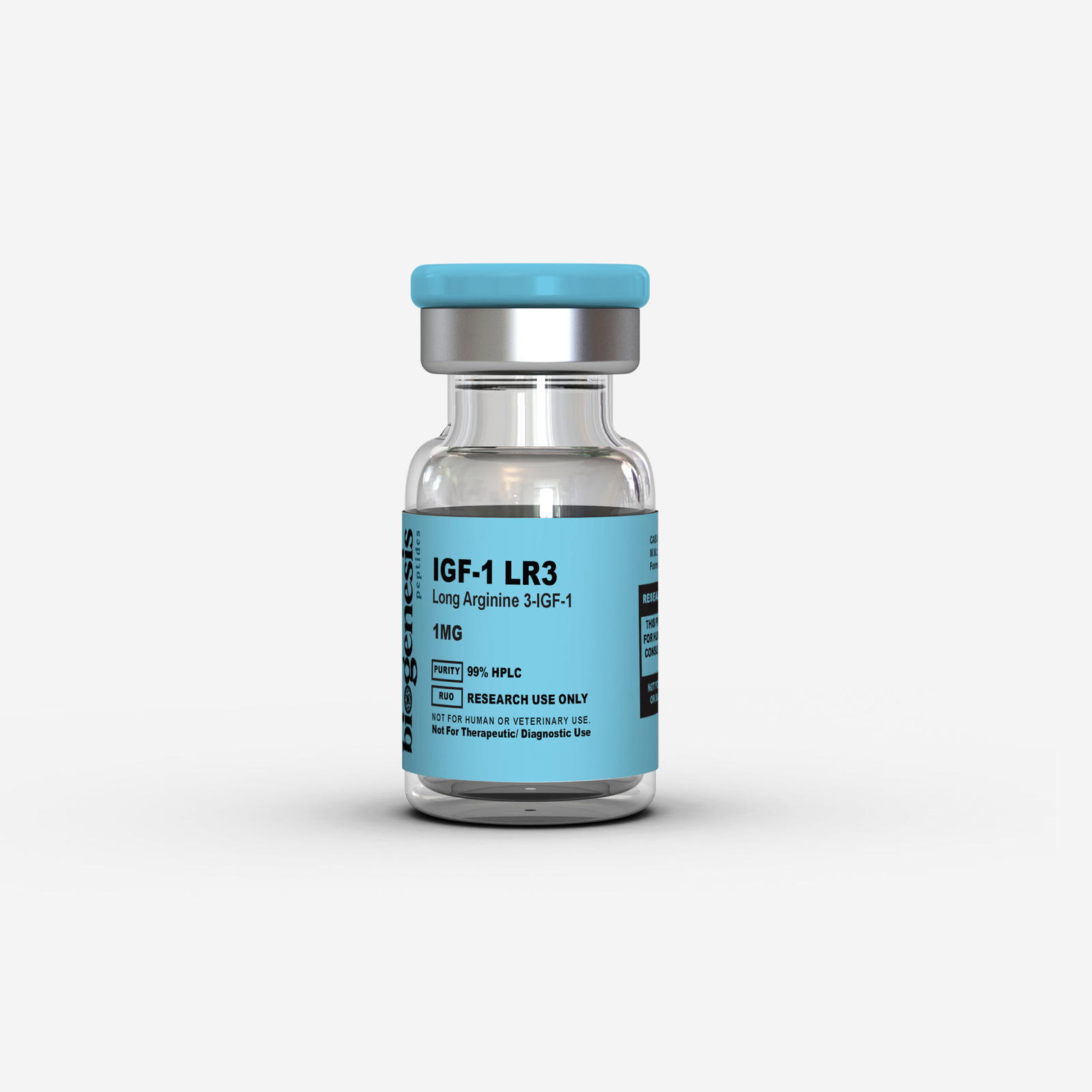Product Usage
THIS PRODUCT IS INTENDED AS A RESEARCH CHEMICAL ONLY. This designation allows the use of research chemicals strictly for in vitro testing and laboratory experimentation only. All product information available on this website is for educational purposes only. Bodily introduction of any kind into humans or animals is strictly forbidden by law. This product should only be handled by licensed, qualified professionals. This product is not a drug, food, or cosmetic and may not be misbranded, misused, or mislabeled as a drug, food, or cosmetic.
IGF-1 LR3 1mg
IGF-1 LR3 (Insulin-Like Growth Factor-1 Long R3) is a synthetic modified form of IGF-1, designed to extend its biological activity by preventing binding to IGF-binding proteins. This modification makes IGF-1 LR3 up to 120 times longer-lasting than standard IGF-1, significantly enhancing its effects on cell growth, metabolism, and muscle repair.
$80.00
Peptides will arrive in a lyophilized (powder) form for maximum stability
Buy 5 for 5% off
Buy 10 for 10% off
Buy 15 for 15% off
OVERVIEW
IGF-1 LR3 (Insulin-Like Growth Factor-1 Long R3) is a synthetic modified form of IGF-1, designed to extend its biological activity by preventing binding to IGF-binding proteins. This modification makes IGF-1 LR3 up to 120 times longer-lasting than standard IGF-1, significantly enhancing its effects on cell growth, metabolism, and muscle repair.
Research suggests IGF-1 LR3 may:
- Stimulate cell division and tissue growth, affecting muscles, bones, nerves, and vital organs.
- Enhance fat metabolism, leading to reduced adipose tissue and improved glucose regulation.
- Support muscle repair and hypertrophy, by counteracting myostatin’s inhibitory effects.
- Promote longevity and cellular maintenance, by reducing age-related tissue degeneration.
- Protect against glucocorticoid-induced muscle loss, supporting muscle preservation in individuals undergoing corticosteroid therapy.
Due to these properties, IGF-1 LR3 has been explored in muscle-wasting conditions, diabetes research, and anti-aging therapies.
RESEARCH
IGF-1 LR3 and Cell Growth
- IGF-1 LR3 is a potent stimulator of cell division and proliferation.
- Primarily affects muscles and bones, but also influences liver, kidney, nerve, skin, lung, and blood tissues.
- Longer circulation time compared to IGF-1, making it more effective in promoting cell maturation and tissue regeneration.
- Potential application: Regenerative medicine and muscle recovery.
IGF-1 LR3 and Fat Metabolism
- IGF-1 LR3 binds to insulin receptors, enhancing glucose uptake in muscle, liver, and nerve cells.
- This leads to lower blood sugar levels, triggering fat breakdown and a net decrease in adipose tissue.
- Potential application: Obesity management and diabetes therapy.
IGF-1 LR3 and Muscle Growth (Myostatin Inhibition)
- Myostatin is a natural inhibitor of muscle growth—IGF-1 LR3 blocks its effects, allowing enhanced muscle repair and hypertrophy.
- Research suggests IGF-1 LR3 may be beneficial for conditions such as Duchenne Muscular Dystrophy (DMD) and muscle atrophy due to immobility or chronic illness.
- Potential application: Muscle-wasting disorder treatment and sports performance research.
IGF-1 LR3 and Longevity Research
- IGF-1 LR3 supports tissue repair and maintenance, offering protective benefits against age-related decline.
- Studies in livestock models (cows and pigs) suggest IGF-1 LR3 can counteract cellular aging effects.
- Ongoing research in mice explores IGF-1 LR3’s role in preventing dementia, muscle loss, and kidney disease.
- Potential application: Anti-aging and age-related disease prevention.
IGF-1 LR3 and Glucocorticoid Protection
- Glucocorticoids are commonly used anti-inflammatory drugs, but long-term use can cause muscle wasting, fat gain, and bone density loss.
- IGF-1 LR3 counteracts these negative effects, allowing for more effective corticosteroid therapy with reduced side effects.
- Potential application: Muscle preservation in patients undergoing glucocorticoid therapy.
STRUCTURE
- Molecular Formula: C₄₀₀H₆₂₅N₁₁₁O₁₁₅S₉
- Molecular Weight: 9117.5 g/mol
- Amino Acid Sequence:
MFPAMPLSSL FVNGPRTLCG AELVDALQFV CGDRGFYFNK PTGYGSSSRR APQTGIVDEC CFRSCDLRRL EMYCAPLKPA KSA - CAS Registry Number: 946870-92-4
CITATIONS
- Adipose Tissue-Derived Stem Cell Secreted IGF-1 Protects Myoblasts from the Negative Effect of Myostatin. Hindawi Journal.
- N. Li, Q. Yang, R. G. Walker, T. B. Thompson, M. Du, and B. D. Rodgers. Myostatin Attenuation In Vivo Reduces Adiposity, but Activates Adipogenesis. Endocrinology (2016).
- E. Corpas, S. M. Harman, and M. R. Blackman. Human growth hormone and human aging. Endocr. Rev. (1993).
- W. E. Sonntag, A. Csiszar, R. deCabo, L. Ferrucci, and Z. Ungvari. Diverse roles of growth hormone and insulin-like growth factor-1 in mammalian aging: progress and controversies. J. Gerontol. A. Biol. Sci. Med. Sci. (2012).
- IGF-I/IGFBP system: metabolism outline and physical exercise. NCBI.
- B. Y. Hanaoka, C. A. Peterson, C. Horbinski, and L. J. Crofford. Implications of glucocorticoid therapy in idiopathic inflammatory myopathies. Nat. Rev. Rheumatol. (2012).
- A. Philippou, A. Halapas, M. Maridaki, M. Koutsilieris. Expression of IGF-1 isoforms after exercise-induced muscle damage in humans. J. Musculoskelet Neuronal Interact. (2007).
- A. Philippou, E. Papageorgiou, G. Bogdanis, A. Halapas. Characterization of the MGF E peptide actions in vitro. In Vivo (2009).
All products on this site are for Research, Development use only. Products are Not for Human consumption of any kind.
The statements made within this website have not been evaluated by the US Food and Drug Administration. The statements and the products of this company are not intended to diagnose, treat, cure or prevent any disease.
Biogenesis Peptides is a chemical supplier. Biogenesis Peptides is not a compounding pharmacy or chemical compounding facility as defined under 503A of the Federal Food, Drug, and Cosmetic act. Biogenesis Peptides is not an outsourcing facility as defined under 503B of the Federal Food, Drug, and Cosmetic act.

